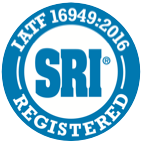Powder Metal Gears
As a leading precision powder metal parts manufacturer, Atlas Pressed Metals provides a wide variety of powdered and sintered metal gears for several applications in multiple industries. The manufacturing of sintered metal gears can present many challenges for conventional metal forming technologies. Gear geometries are inherently complex, often requiring time-consuming secondary machining processes – adding cost to the bottom line. It is in this realm where powder metallurgy excels.
Through the use of precision tooling, a range of tonnage compaction presses, and sintering capabilities, gears may be manufactured using the powdered metal process, to near-net-shape or even net shape, requiring little or no secondary operations such as machining, and at cycle times considerably faster than machining operations.
As a powder metal parts manufacturer, Atlas not only makes powder metal gears, but we also manufacture metal parts such as precision powdered metal bearings, structural components, and more.
Benefits of Using Powdered Metal in Gear Manufacturing
Utilizing powder metallurgy for gear manufacturing provides many additional benefits, including tight tolerances, dimensional accuracy, and consistency, as well as the capacity for all production volume requirements. A key benefit of using powdered metal for sintered metal components is its cost-effectiveness due to its high material utilization. The ability to produce gears to tight tolerances also eliminates or reduces the need for additional operations, often resulting in savings of both production time and cost.
With little to no waste, powdered metal is a green process due to its low energy usage and minimal scrap, making it more economical than standard machining, casting, or most other metal forming technologies Material selection for gears allows for optimization of the component’s performance for its intended application with little variation in the manufacturing process.
At Atlas Pressed Metals, our team has a deep understanding of more than just sintered metal component manufacturing. We also provide a high level of expertise in engineering and the material science surrounding powdered metallurgy. This means that we can recommend metal powders that help our customers in designing metal components that will optimize performance. When a properly selected material is combined with appropriate process parameters, the result is a finished component that meets the application requirements with proven cost-savings over other metal forming choices.
Additional benefits to using powdered metallurgy for gears include the following:
- Lower tool cost
- Consistent reproducibility
- Tight tolerances as compared to castings and stampings
- Cost-effective as a manufacturing process
- Ability to accommodate low to high volume (5000 to 5M+ annual volume)
In addition, the design features of powdered metallurgy eliminate the need for draft angles and shear which would be necessary in a casting or stamping design.
Applications for Sintered Gears
Various industries use powdered metal manufacturing for their gears. Some of these industries include appliance, automotive, medical, outdoor power equipment, power tools, lawn and garden, and marine applications.
Some gear types suitable for PM include, but are not limited to:
- Spur
- Helical
- Bevel
- Pinion
- Combinations
- Spiral Bevel
- Rack
Considerations for powder metal manufacturing for gears include:
- Due to pressing and tooling capabilities, powder metal may not be suitable for worm gears, herringbone gears, and helical gears with helix angles exceeding 22˚.
- The size of the gear is limited to the compaction press size needed to form the component.
- The depth of the die needed for thickness or face width may limit the production of certain gears.
- Requirements for lower volumes may not be cost-effective.

Materials Used for Manufacturing Powder Metal Gears
The powder metallurgy process begins with a collection of metal powder particles.
Metal powders are engineered materials that meet a wide range of performance requirements. Understanding the powder is crucial in powder metallurgy as this is the key input to the production of a final metal component.
The powder is produced through either solid-state reduction, atomization (gas, water, or centrifugal), electrolysis, or chemical treatments of the metallic material.
Atomization is the typical method used today. It involves the conversion of molten metal in a spray of droplets that solidify into powder. Water atomization is the most common form of atomization as it results in irregularly shaped particles, which is beneficial in the compaction of powder metal component production.
Metal powders are classified as elemental, partially-alloyed, or pre-alloyed. Elemental powder is a granular form of pure metal powder. They are the building blocks of creating alloys and composite materials. Partially-alloyed powders are a mixture of elemental powders of different materials blended together, and a prealloyed material is in an alloyed state as produced by atomizing a combination of metals.
In most cases, the powder mixture, whether elemental or prealloyed, also contains additives (lubricants or binders) for increased tool life, to assist in the ejection of the component from the compaction die or to hold the metal part together before the sintering process. These additives are removed from the component desiring the sintering process.
The geometry of the individual powder is defined by particle shape and internal structure, particle size and distribution, and surface area. Particles come in a variety of shapes, from spherical, irregular, flake, dendritic, and sponge. The distribution of particle sizes in the powder influences compaction as smaller particles will fill in the void between larger particles. This combination of sizes improves compaction density and material properties.
These are critical parameters in powder metallurgy as they determine how the powder performs when filling the die, during compaction, and in sintering. These factors must be optimized to achieve the desired strength and density in the green stage and in the final sintered component.
Powder Materials for Gears
A broad range of base powder metal materials is appropriate for gear manufacturing. These include brass, bronze, iron, low-alloy steels, infiltrated steel, and stainless steel. As with other powder metal components, the selection of materials takes into consideration the required mechanical and physical properties, application, and cost. Designing the correct mix of elemental powders allows for an alloy composition that will satisfy the component requirements.
The materials commonly used for gear production include Iron-Nickel and Nickel Steel, which are admixtures of elemental iron, nickel, and graphite (when required) powders. These materials provide heat-treatable structural parts that require strength, wear resistance, and impact properties. Prealloyed Steel is developed from pre-alloyed low-alloy steel powders with nickel, molybdenum, manganese, and chromium as alloying elements. Prealloyed steel is used for components that require heat treatment to increase strength and wear resistance. Other powders include Hybrid Low-Alloy Steel and Diffusion-Alloyed Steel.
Sinter Hardened Steel is often a good choice of material when the component requires high strength, wear resistance, and tolerances. This powder is hardened as part of the sintering process and provides improved dimensional control, cleanliness, and a reduction in processing steps versus other heat treatment options. However, sinter-hardened materials are not easily machined.
Atlas ships nearly 1 million gears per year to a variety of industries and applications!

Additional Efficiencies of PM Gear Manufacturing
Atlas Pressed Metals, a leading powdered metal gears manufacturer, is equipped with a wide range of state-of-the-art automation and material handling systems, adding greater efficiency to an already highly efficient process. We also provide extensive finishing capabilities for gears; these include machining, sizing, plating, and heat treating. Other finishing options include the impregnation of lubricants, resins, and sealers, as well as standard and specialty coatings.
Onsite equipment used for the manufacturing of powdered metal gears includes a compaction press, sintering furnace, and secondary machine operations if needed.
Additional advantages for the manufacture of powder metal gears include:
- Economies of scale for mass production
- Repeatability and consistency of required geometry, dimensions and tolerances
- Better performance of the gear in its specific assembly
- Ability to produce multilevel gears
- Use of controlled density or management of porosity per the application requirements
- Self-lubricating if required
- The improved surface finish on the gear teeth
- Sound dampening
- Reduction or elimination of secondary operations
- Weight reduction when needed
Custom Powder Metal Gears Specifications
Atlas Pressed Metals’ capabilities include, but limited to:
- Weight: Up to 6800 grams (15 lbs.)
- Diameter: 3mm (0.125”) to 250mm (10”)
- Length: 3mm (0.125”) to 76mm (3”)
- Geometries: Gears with flanged, multi-level, helical, and bevel features
- Gear geometry is controlled through AGMA Composite Action Method of Evaluation as defined in AGMA 2000-A88 4.2.1.2.
Understanding Powder Metallurgy
Step One: Collaborative review of your new part design or an evaluation of a potential conversion to powder metal for an existing part
Step Two: Selecting the best powder or powder blend for durability, reliability, and accuracy
Step Three: Compacting the metal powder to precise specifications under controlled pressure
Step Four: Heating or "Sintering" to create a permanent form
Contact us to learn more about powdered metal manufacturing, material requirements, and how the powder metal process can reduce the cost of your next structural component project.
We are ready to help! We would love to touch base with you to provide more information on how Atlas can help you with your next sintered metal gear design.
contact information
Mailing Address
125 Tom Mix Dr.
P.O. Box P
DuBois, PA 15801
USA
Fax(814) 371-4182
testimonials
“Atlas Pressed Metals is meeting our expectations, especially in engineering and design. They manufacture with excellence; quality driven components and they work the first time. The staff is easy to work with and have a great attitude. We would definitely recommend them.”
.png)





